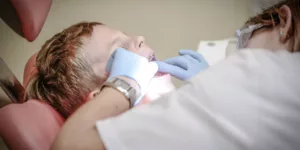Orthodontic work is typically something that children don’t need to worry about until they have lost their baby teeth. While it is a good idea to have your dentist examine your child’s jaw and tooth structure to ensure that there aren’t any obvious signs of major dental issues, it is also important to have a professional orthodontic exam early on. New research is revealing that for some orthodontic issues, early intervention can be the key to correction and is a highly effective way to decrease the overall length of orthodontic treatment.
For children who have something what are commonly referred to as “buckteeth,” early intervention might be the key to limiting dental trauma in their youth. It is estimated that as many as one in three children who were treated early were less likely to experience severe dental trauma that can lead to issues with their permanent teeth suffering chips, being broken, or even being lost. Since children are active and can be more prone to falls, if they have extremely protruding teeth – which is the case with buckteeth – they are more likely to experience traumas that can lead to permanent damage.
Young children are also more likely to have complications because of their mouth structure. Since they do not have lip coverage to protect teeth that jut out too far, they suffer more loss and damage when the issue is not addressed in childhood. Since everyone is only afforded one set of permanent teeth, it is important for children to keep the ones they have safe through early intervention. When you lose a permanent tooth, the consequences and the cost are much more severe. Problems with permanent teeth can also be ongoing, with the teeth needing to be replaced several times throughout their adult years.
Recent statistics reveal that up to 15% percent of children ages 12-15 require orthodontic work in the United States, and one of the most common reasons for treatment is buckteeth or highly protruding teeth. Recommendations are that children get treatment before adolescence, but new findings might indicate that children can benefit from much earlier intervention than what is currently suggested, at or around the age of 7. If your child is showing signs of buckteeth, then it is thought that they should seek orthodontic care before the recommended average age.
By addressing issues earlier, a professional orthodontist can work with the patient to find the best strategy or phases of orthodontic work, so that they can correct both the bite and the placement of teeth at the appropriate time. For children who have severe issues, getting corrective care might be warranted and highly beneficial to save them from the risk of damage that can hurt their permanent teeth and can’t be undone.
And it’s not just about the risk of harm to the teeth from trauma or falls; when a child has a severely buck teeth, it causes them to bite ineffectively. That puts more wear and tear on teeth, which can lead to tiny cracks in the tooth’s surface. Those tiny cracks can lead to dental caries, tooth decay, and – in extreme cases – tooth loss, if not corrected at the appropriate time.
Children with buckteeth are often picked on by their peers for their appearance as well. Since the early years are a time when many children develop their sense of self-esteem, having something that stands out or makes them the target of ridicule can lead to a different type of trauma. The emotional scars from being made fun of, even if your child’s bite is fixed, can create permanent feelings of insecurity that might follow them through their adult lives.
You only get one set of permanent teeth in your lifetime. Make sure to keep your child’s safe from being harmed, especially if you notice signs that your child’s bite might be off or if they have teeth that are protruding abnormally. It is an excellent idea to intervene early to devise a plan with an orthodontic professional to fix the issue, to save them both from dental trauma and emotional trauma going forward.








